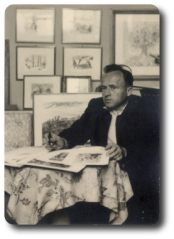
Václav Karel
Czech painter, graphic artist and illustrator
*October 21, 1902 in Dobric near Plzen
+ December 28, 1969 in Prague
Born on October 21, 1902 in Dobric near Plzen, died in Prague on December 28, 1969 Education:School of Ceramics in Bechyně (1919), School of Decorative Arts in Prague under the supervision of Profs. Masek and Kysela (1927) and Academy of Visual Arts
under the supervision of Max Svabinský and T.F. Simon (1929). Shortly afterwards he won a scholarship to Paris. Until 1945 KAREL concentrated the techniques of woodcut, in oil painting he prefered flowers and landcapes.
Václav KAREL was shy. His life was affected by an accident, which he suffered in his adolescence and so he disliked appearance in public.
His first one-man-show was held in Hradec Králové in 1933. In 1939 he was accepted as a member of the artist´s club Umelecká beseda and exhibited regularly. His first exhibition in Prague was held in 1943.
He was deeply affected by the American mistaken bombardment of Prague in February 1945. His apartment and studio were destroyed (the actual site of the Dancing House). All his paintings to that date were lost. He and his wife escaped with only their lives. KAREL later regretted especially above all the loss of his sketchbooks. Thanks to his friendship with the famous photographer Joseph Sudek some photos of his work were preserved.
The painter was forced to start again from the beginning when he gave preference to illustration work in magazines, e.g. the children’s weekly magazine – Materidouska. He created charts for schools, e.g. Live alphabet and illustrated textbooks, calendars, postcards and so on. KAREL became an important sought-after illustrator. He provided the illustrations for works about the child´s world e.g. Czech national fairy tales, poems and rhymes by K.J. Erben, B. Nemcova, J. Kozisek, J.V. Sladek.
The name KAREL is not well known but older people consider their favourite childhood books to be those illustrated by KAREL. Illustration workload prevented KAREL from painting creatively. KAREL only went back to oil painting in summer usually waiting a long time to finish them and only a few were signed. In his later years KAREL had more time for his real love, paintings. In 1968 his oil Sisyphus at the Prague salon attracted attention. As a symbol of protest against the Russian occupation KAREL painted another oil, Tree sign showing on two tree trunks the end of Prague spring – black crows came in from the East.
The internationally – known Czech artist Adriena Šimotova remembers: „…our studios were near each other and we were good friends. Václav KAREL was an unusualy shy and vulnerable man but his inner power enabled him to overcome all his selfconsciousness. What really surprised me was the extent of his poetic vision of the world: butterflies, flowers, and his intimate view of nature, almost fabulously symbolic. His best work with its lyric fantasy reminds us of the French painter Odilon Redon, very poetic and unconventional. KAREL painted two series of small pictures named Osamelé ostrovy (Lonely Islands) and Opustené truny (Abandoned Thrones)…”
In the 1960s KAREL took part in the exhibitions of Czechoslovakian visual arts in Germany, Wales, France, Italy, Bulgaria, USSR, China and Vietnam. After his death two exhibitions were held in Prague in 1971 and 1977. To celebrate the centenary of the artist´s birth in 2002 a series of comprehensive exhibitions were held in a Western Bohemian gallery in Plzeň, in Vyšehrad Gallery in Prague, at a Gallery of Havlickuv Brod, in the Czech Cultural Center in Dresden and in Italy in Villanuova sul Clisi (Lago di Garda). Then followed by other exhibitions in several small regional galleries in Czech Republic, in France and once again in Italy in Castenedolo near Brescia. The last major expositions were held in Stary Plzenec 2008, in Slovacka Gallery Uherske Hradistě in 2012, in Italy – in Brescia 2013 and in the Gallery Galvína in Bechyne 2013 and again in 2019, and more in Horovice 2021, in Zbiroh in 2022, in Pilsen 2023, in Beroun in 2024 and finally in Rakovník in Autumn 2024.
